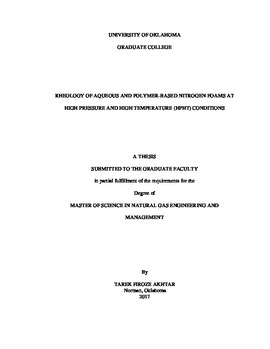| dc.description.abstract | Foams are complex mixtures of gas and liquid held together by a surfactant at the gas-water interface. The use of foams find application in many industrial operations such as underbalanced drilling fluid, fracturing fluid in well stimulation, injection fluid in enhanced oil recovery technique, and fire-extinguishing agent in firefighting. Applicability of foam depends on its viscosity and stability. Rheological behavior of foams is mainly a function of foam quality (i.e. gas volume fraction), base liquid viscosity, pressure, and temperature. The method of foam generation and foam stability are also factors that affect its rheology. Foams are two main types when used for underbalanced drilling purposes: aqueous foams and polymer-based foams.
This thesis presents results of the experimental investigation conducted to study the effects of foam quality, pressure and wall slip on aqueous and polymer-based foam rheology. It also seeks to establish a new method for the prediction of yield stresses. Flow experiments were performed using a foam recirculating flow loop that has three pipe viscometers in a parallel configuration. Experiments on aqueous foams were carried out at ambient temperature (23.8 ± 1% °C), and varying pressures (6.89 13.79 and 20.68 MPa). Tests on polymer-based foams were conducted at high pressure (6.89 MPa) and varying temperatures (23.2, 76.7 and 107.2 °C). All tests were performed using three pipe viscometers with different diameters (3.06, 6.22 and 12.67 mm). Pressure losses across the viscometers were measured at different flow rates (0.1 to 1.1 L/min). Foam was generated by flowing a mixture of base liquid (water/water +0.25% PAC with 2% surfactant) and nitrogen through a needle valve. The pressure drop across the valve was measured and maintained approximately at a constant value (298.8 kPa). Before each measurement, foam was regenerated by circulating the fluid at the maximum flow rate. All measurements were taken in laminar flow. Results indicate strong non-Newtonian behavior of foam, which closely fits the power law model for shear rate range considered in this investigation. Noticeable flow curve shifting, which may be an indication of wall slip, was not observed when tests were conducted varying pipe size. Secondary pressure effect, which is foam viscosity change because of pressure variation at a constant foam quality, was negligible but rheology variations at high temperatures were seen for polymer-based foams. High-quality foams (quality greater than 65%) displayed yielding behavior when the flow is gradually reduced to zero. | en_US |
